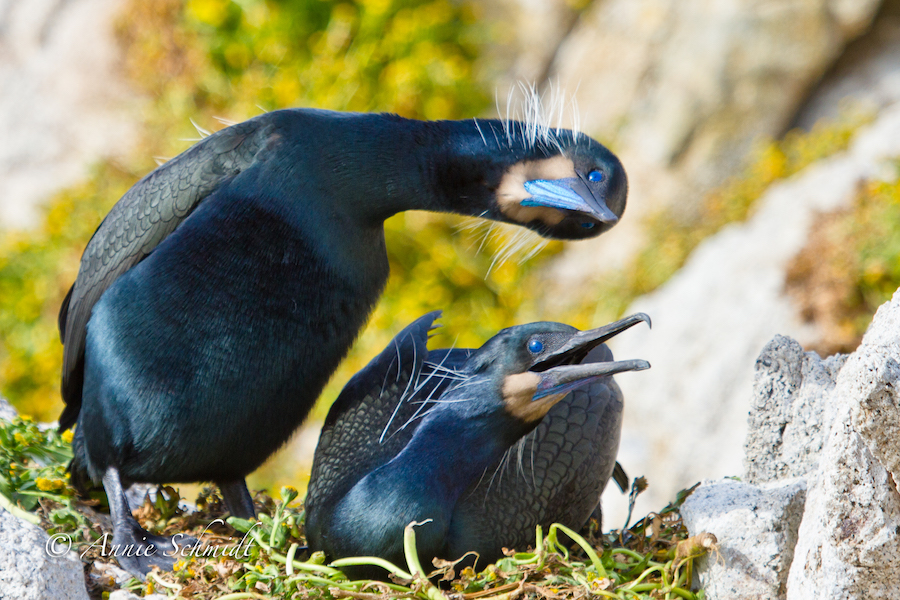
UC Davis study shows potential responses of long-lived seabirds to changing ENSO frequency
Brandt’s cormorants are seabirds native to the Pacific coast. They’re black and sleek, with long necks, oval bodies, and bright blue chins. The oldest recorded Brandt’s cormorant was seventeen years of age, a relatively long lifespan for a bird species. A recent study of these birds has provided new information about the effects of climate change on this long-lived marine species and potentially others as well. For decades their population has been monitored in the Farallon Islands just off the shores of San Francisco, providing valuable information about ocean conditions, local fisheries and the community of the island wildlife refuge.
“Since we have that kind of data, we were able to understand that [the cormorants] tend to respond pretty quickly to things like El Niño conditions, which are really broad, large-scale patterns that influence the whole globe,” said Annie Schmidt, the lead author and a former doctoral student at UC Davis currently working for Point Blue Conservation Science. “And because they respond really sensitively to those conditions, you can tell a lot about how El Niño is affecting the ecosystems here in California.”
The El Niño-Southern Oscillation is a periodic fluctuation in winds and surface temperature that occurs over the eastern Pacific Ocean. The warm phase, El Niño, pushes warm water to the surface along the Pacific coast, and is followed by a cooler phase called La Niña, which pulls up colder waters. Biological activity tends to decrease during El Niño, resulting in less food, less breeding and lower adult survival. Climate change may alter the current fluctuation.
“There are sound papers and more coming out all the time that predict ENSO cycles will likely increase in intensity and frequency, probably too fast for many marine wildlife populations to adapt,” said Daniel Anderson, a professor emeritus of Wildlife Biology at UC Davis, in an email interview. “Each [seabird] species has its particular ecological ‘strengths’ and/or ‘weaknesses’ that contribute to their vulnerability for population decline or increase. But whole marine ecosystems are at risk, of which seabirds are part.”
Schmidt and her colleagues took various predictions for future changes in ENSO frequency and applied them to population models for Brandt’s cormorant. These models looked at population abundance, variation in recruitment and extinction probabilities for several potential ENSO patterns.
“The basic thing that makes populations susceptible to extinction is being held down at a low level for a long period of time,” said Louis Botsford, a co-author and professor emeritus of the Department of Wildlife, Fish, and Conservation Biology at UC Davis. “Imagine a species that only lived for one year. If it only lived for one year, then if it appears during one of these low periods, it’ll go extinct. […] The cormorant, on the other hand — its lifetime spreads over seventeen or twenty years or something like that. Its reproduction occurs over a combination of ups and downs. This does cause fluctuations in the number of young, which, when they join the adult populations, do cause some fluctuations in the adult populations, but not as much as a shorter-lived species would.”
Overall, increasing ENSO frequency appeared to benefit the long-lived species in all three categories. It is not certain that the frequency will actually increase as La Niña is still not yet well understood, and climate change predictions are highly variable. However, other long-lived marine populations with similar reproductive patterns — in other words, species with similar life histories or sensitivity to ENSO — may be better understood at a population level by incorporating these models.
“I think the main thing we’re hoping to come out of this is that people think about including the frequency of both good and bad — for lack of a better term — events in their population forecasting,” Schmidt said. “Often if people are trying to predict how a population will respond to future climate change, they might predict how it will respond to changes in the mean conditions. So let’s say your average temperature is warmer or cooler or whatever the case may be. Or they might predict how it would respond to more extreme conditions, but people have not often considered frequencies. So how often good and bad years are alternating, when they’re trying to predict how a species will persist in the future, it turns out is pretty important.”
Written by: Kira Burnett — science@theaggie.org



